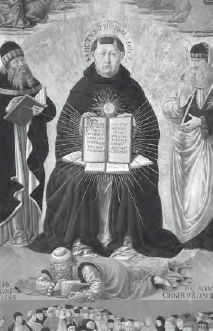Although Thomas Aquinas (1224–1274) was deeply influenced by the work of the Aristotielians, as well as the stoics, Neoplatonists, and St. Augustine (354–430), his resolution of past philosophy with Christian theology is considered unique. Many of his solutions to standing problems display moderation without intellectual compromise. For instance, his position on universals (whether or not general terms name general things that exist), is even called “moderate realism.” Aquinas did not believe that universals exist, but he did posit a foundation outside of the human mind for universals and truths about them. That foundation was the fact that individual things of the same kind, which are referred to by the name of that kind (e.g., specific cats that are called “cats”) have real similarities and resemblances. Whether or not this solution did more than restate the problem remains an open question, but it definitely impressed many as a new way of thinking about the old problem of universals.

St. Thomas Aquinas sits between Aristotle and Plato; St. Thomas is still considered one of the most important philosophers to have ever lived (Art Archive).

